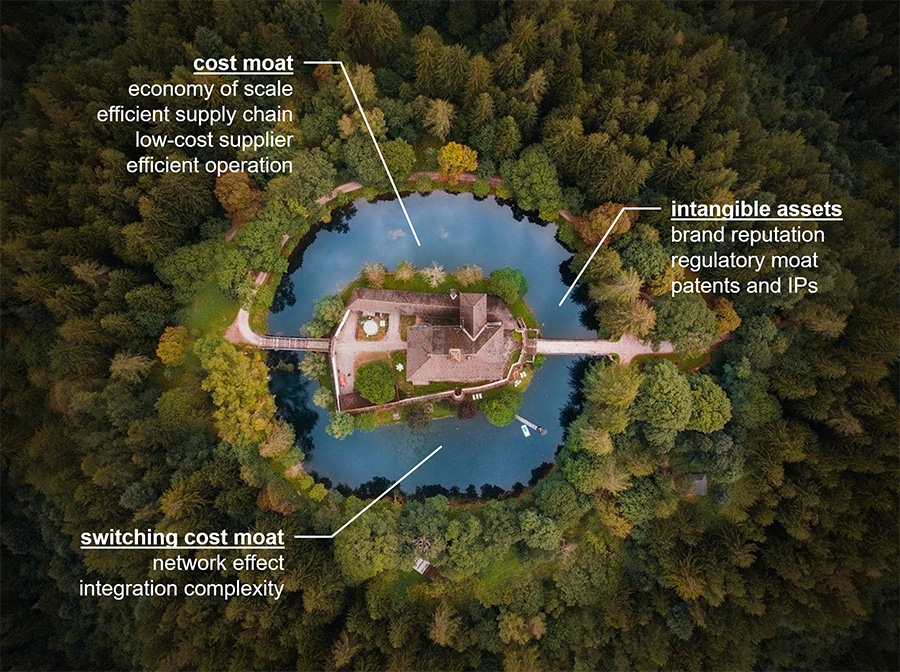Building a Unique Moat – Part 1: Common Strategies
Recently, I have been in conversation with a few of my old friends from Taiwan. This personal chit-chat for catching up turned into an academic debate about the success factors in some of the best AI companies in the world. Subsequently, this conversation evolved into how those companies and other thriving enterprises create lasting competitive advantages that enabled them to grow and become global players. In today’s volatile and disruptive business landscape, this engaging discussion holds immense significance and relevance. So I’ve decided to turn this into a 3-part mini-series here. I hope you will enjoy it and glean some insights from it.
Most successful companies that stand the test of time usually have some kind of moat. These economic moats are competitive advantages that allow a company to maintain its market share and profitability over an extended period. Just as a moat around a castle provides protection from potential intruders, economic moats protect a business from competitors and challengers. This concept was introduced by the legendary Warren Buffett, who used it to describe businesses with enduring competitive edges.
There are many types of effective moats. The following are some common strategies that companies leveraged to build their moat.
Cost Moat
More traditional industries like manufacturers or distributors may invest a substantial amount to build a factory or a railway line. These infrastructures provide a formidable advantage in terms of scale and cost efficiency, protecting the company’s interests for an extended period. There are many mechanisms to achieve cost efficiency. For example, economies of scale can provide cost advantages by enabling companies to produce goods or services at a lower cost per unit. Other mechanisms include efficient supply chains, low-cost suppliers, and efficient operations through advanced technology (e.g. Walmart, Amazon, etc.).
Switching Cost Moat
Internet and tech companies have even stronger moats by taking advantage of technology’s capability to scale with complexity and user base. There are 2 mechanisms that create high switching costs.
- Network Effect: Social media platforms and online marketplaces are famous for leveraging this moat. Their already large and growing user base makes the platform even more valuable to their users, so their users cannot switch without a significant loss of value. So their existing user base becomes a potent moat, safeguarding the company’s position (e.g. Facebook, Airbnb, etc.).
- Integration Complexity: Tech companies can often achieve high switching costs by providing complex solutions that are deeply integrated into their customers’ daily operations (e.g. Oracle, Microsoft, etc.). This not only makes it technically difficult but also disruptive and costly (in terms of time and human resources) to switch.
Intangible Assets
Companies also have many intangible assets that provide a protective moat against challengers. Although this moat can include everything from special customer relationships to exclusive partnerships, there are 3 common mechanisms companies leverage to create a moat using their intangible assets.
- Brand Reputation: The most important intangible asset for a company is the brand. Companies with strong brand recognition and customer loyalty have significant competitive advantages. While it takes a long time and a tremendous amount of marketing dollars to build a strong brand, once built, it allows these companies to charge premium pricing and maintain market share (e.g. Apple, Coca-Cola, etc.).
- Regulatory Moat: Companies operating in heavily regulated industries benefit from barriers to entry created by government regulations and compliance requirements. These industries tend to have significant impacts on consumers’ safety and well-being. For example pharmaceutical (e.g. Johnson & Johnson, Merck, etc.), insurance companies, healthcare providers, utilities, and even airlines.
- Patent and IPs: By owning valuable intellectual properties, companies can prevent competitors from using similar technology or products (e.g. Qualcomm, Pfizer, etc.). Although proprietary know-how can offer some protection initially, it’s often a matter of time before such proprietary knowledge becomes common knowledge in a world where employees are free to switch employers.
Conclusion
Economic moats are important as they protect your business. Having a moat is the easy part. Making sure that it’s impenetrable is where the effort lies. Whether you are a leader or a strategist in a company, it is always important to think about which moat you already have, which you want to develop, and how to fortify them.
Turning the table around, if you are an investor (whether you are a seasoned day trader, a Warren Buffett wannabe, or you simply invest personally), wouldn’t you want to invest in a company with well-fortified moats? Now you know how to identify them, how do you gauge their strength? If a company’s differentiation is its offense, then its moat would be its defense. And you need both good defense and offense to win the game, especially in this tough global business environment.


